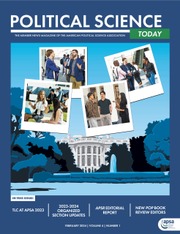This report details Perspectives on Politics’ editorial processes and journal performance for 2024. This year marked the first full year under the leadership of the journal’s Co-Editors-in-Chief, Ana Arjona and Wendy Pearlman of Northwestern University, and Book Editors, Anne Wolf of University of Oxford, Kathrin Bachleitner of University of Salzburg, and Sarah Bufkin of University of Birmingham. During this year, the journal benefited greatly from continuity in the editorial team’s personnel from 2023. The four editorial assistants from Northwestern University, Jinxue Chen, Elizabeth Good, Jack McGovern, and Sarah Moore, all returned for the entirety of 2024. Furthermore, our managing editor Jennifer Boylan (APSA) continued to provide expedient and thorough management of day-to-day operations of the journal as well as liaising with Cambridge University Press. In addition to carrying over personnel from 2023, the journal welcomed Shmuel Nili of Northwestern University in August 2024 to serve as associate editor to oversee editorial processes for political theory submissions.
Though the predominant focus of this report relates to journal operations and editorial decisions throughout 2024, many of the articles included in the issues published during the past year were initially reviewed and managed by the journal’s former editors, Michael Bernhard and Daniel I. O’Neill, as well as the rest of the University of Florida editorial team. Our team’s success in planning and publishing the issues composing Volume 22 was only possible given the previous team’s dedication and service to the journal. We remain thankful for their prior stewardship.
In the sections that follow, we discuss the editorial innovations that our team has implemented in the past year, as well as key journal performance metrics. The editorial innovations that we discuss are limited to the regular editorial processes managed and overseen by the Northwestern editorial team. The performance and publication indicators presented reflect information on both regular and book review submissions.
EDITORIAL INNOVATIONS
CONTINUED OPTIMIZATION OF INTERNAL PROCESSES
In our first months of service to the journal, our team devoted a great deal of focus to building and implementing clear processes and systematized guidelines to ensure that our editorial processes were efficient and consistent across the two Co-Editors-in-Chief. By the end of 2023, we developed a very detailed Editorial Guidebook that formalized procedures related to submission intake, editorial review, finding and inviting reviewers, and communication with authors, among other crucial tasks carried out by the editorial team. We also created a dynamic, interactive database system to organize our work, allowing us to continuously monitor all submissions within the journal’s pipeline.
Building off the base system that we developed in 2023, we endeavored to update our guidelines and data management system throughout 2024 to further streamline editorial processes and enhance recordkeeping. Some of the changes we implemented this year include an improved signaling feature for manuscripts with late reviewers or that otherwise need more attention; further detailing policies and procedures where proper editorial action required additional clarity or consistency; and building out a relational database that helps track communication with, and requests to, editorial board members for manuscripts that require their oversight, such as in cases of conflict of interest. These changes have resulted in clearer courses of action for editorial decision-making; prompt action to keep review processes advancing as quickly as possible; improved communication among a cross-functional, diffuse team; and increased centralization of all the moving pieces related to successful management of an academic journal.
POLICY DEVELOPMENT
As we further developed our editorial policies throughout 2024, some policies emerged from editorial gray areas, where the proper course of editorial action was not evident, and we needed to deliberate options and determine our best response. Such cases included defining procedures when editors have a conflict of interest with a submitting author or at what point we would make an editorial decision based on three reviews rather than four when the fourth reviewer is extremely late in submitting a promised assessment.
We have also started developing and implementing protocols to ensure that the Perspectives’ policies are in line with increasingly accepted norms and best practices in academic publication. Specifically, we have developed an editorial protocol for post-publication critiques based on the Committee on Publication Ethics’ (COPE) suggested guidelines as well as additional guidelines for reporting on human participants and survey research. These policy developments have yet to take effect pending ongoing discussions with Cambridge University Press and the Perspectives editorial board. Looking toward the current year, we intend to release information on all our editorial policies to ensure that the guidelines informing our decision making are transparent to authors, readers, and the broader academic community.
PLANNING THEMATIC SPECIAL SECTIONS
As we iterated in last year’s report to the APSA (Arjona et al. Reference Arjona, Pearlman, Boylan and Moore2024), we are maintaining the journal’s tradition of thematic programming originally implemented by the University of Florida team through the curation of special sections. Special sections featured in Perspectives group together accepted articles based on shared themes. Each article featured in a special section is an independent submission evaluated by the editorial team and external reviewers. Articles are chosen for special sections only after final acceptance and publication via FirstView, the Cambridge University Press online platform for published articles preceding their inclusion in specific issues.
While specific special sections are highlighted on each issue’s cover, all issues published in 2024 included at least two special sections. Table 1 presents the names of each of the special sections published in Volume 22 and those in bold represent the special sections highlighted on the cover.
Table 1. Special Sections Published in Volume 22
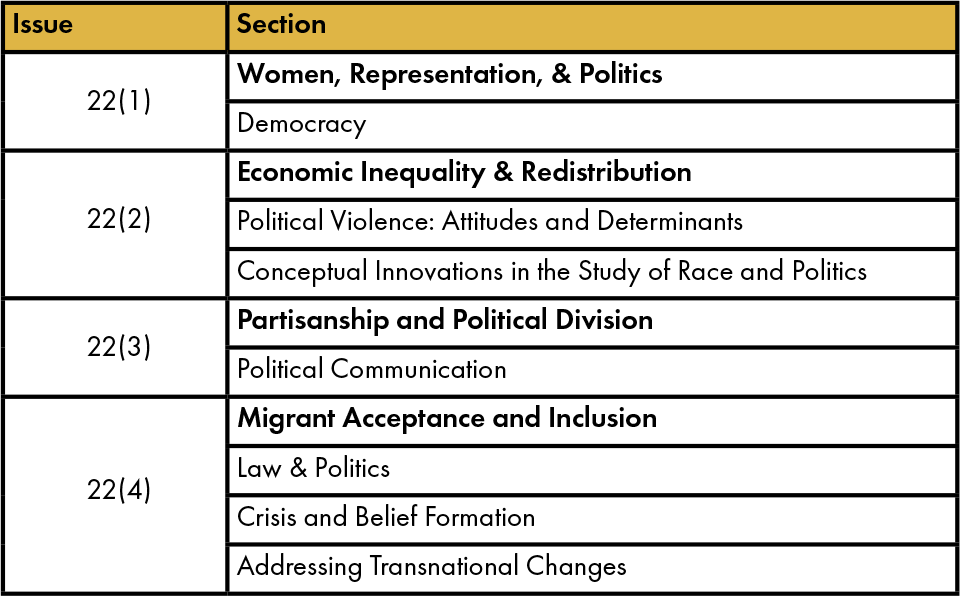
Furthermore, in October 2024, we released a rolling call for papers (CFP) with the deadline of August 1, 2025Footnote 1. The theme of the CFP is “Political Science and the University” and invites “political scientists to use their expertise to explain what is and ought to be happening at institutions of higher education.” Potential papers might address the impact of university on social and political change, how universities function as a site of political control or global diplomacy, or the politics of higher education, among other topics of inquiry examining the nexus of higher education and politics. We recruited a team of three guest editors with expertise relevant to this topic, representing different subfields: Anja Neundorf of the University of Glasgow, Robert Pape of the University of Chicago, and Nicholas Tampio of Fordham University. Our team is working with the guest editors to guide and support their assumption of responsibilities for overseeing the editorial process for submissions related to the special issue. All papers will be reviewed independently and, if accepted, published individually on FirstView. The chosen papers will be featured together in the print version of the special issue.
SUBMISSIONS AND JOURNAL STATUS
EDITORIAL REVIEW
All submissions to Perspectives undergo anonymized initial editorial review by two members of our editorial team. In this process, one editor and one doctoral-level editorial assistant independently evaluate each manuscript’s conceptual, theoretical or empirical contribution, methodological rigor, and whether the manuscript effectively translates the implications of its findings or insights to a broad audience. The two members of the editorial team share their assessments of manuscripts on a weekly basis and decide together if a manuscript is suitable for further external review.
If a manuscript does not meet our criteria for external review, we aim to provide quick turnaround to authors of our initial review decisions. However, special circumstances may require deviation from our typically expedient initial review process, such as in cases where our editorial team has a conflict of interest and must outsource initial review to an editorial board member. When we notify authors that their manuscripts will not be sent for further review, we offer justification for our decision and aim to provide authors with substantive comments that we believe might benefit later iterations of their work. As we noted in last year’s report, we continue to be gratified when authors reach out to express that they have benefitted from this feedback. Correspondence from authors throughout 2024 has only reiterated our commitment to providing all authors with a positive and constructive experience when submitting to Perspectives.
If research articles do not meet our criteria for external review but otherwise make an interesting and broadly engaging conceptual, theoretical, or empirical contribution, we may instead offer authors the opportunity to revise their submission and resubmit it as a reflection article type. In these cases, we provide authors justification for our decision to reject the paper as an original research article and may also offer some insights about what we believe can make the paper succeed as a reflection essay. Authors have a choice in whether they revise their manuscript as a reflection and, if they choose to do so, are welcome to incorporate or disregard our comments. Except for cases with extenuating circumstances, all manuscripts that are revised as reflection essays are sent out to external reviewers upon resubmission.
In the case that a manuscript is sent out for external review, editorial review teams compile a list of potential reviewers based on the theoretical, methodological, and case-specific expertise we deem necessary to evaluate the manuscript. Our final choice of reviewers also attempts to reflect demographic diversity within the discipline. For example, we always aim for gender parity in reviewer slates. Research article submissions are sent to four reviewers, while reflections submissions are sent to three. Our norm is that any submissions that receive at least two recommendations for rejection by external reviewers are rejected. In some cases, we may reject submissions that receive only one recommendation to reject if other reviewers are especially critical despite making recommendations to revise.
SUBMISSIONS AND EDITORIAL DECISION-MAKING
Perspectives received 555 regular submissions, either research articles or reflection essays, in 2024. This indicates that last year’s regular submission volume is greater than that of the previous year and is only exceeded by the submission volume of prior years during which there were calls for papers associated with special issues. Figure 1 shows the number of manuscripts submitted to Perspectives for each year from 2014 to 2024. The dotted-blue line indicates all submissions, including those associated with a call for papers, while the solid orange line indicates only regular submissions.
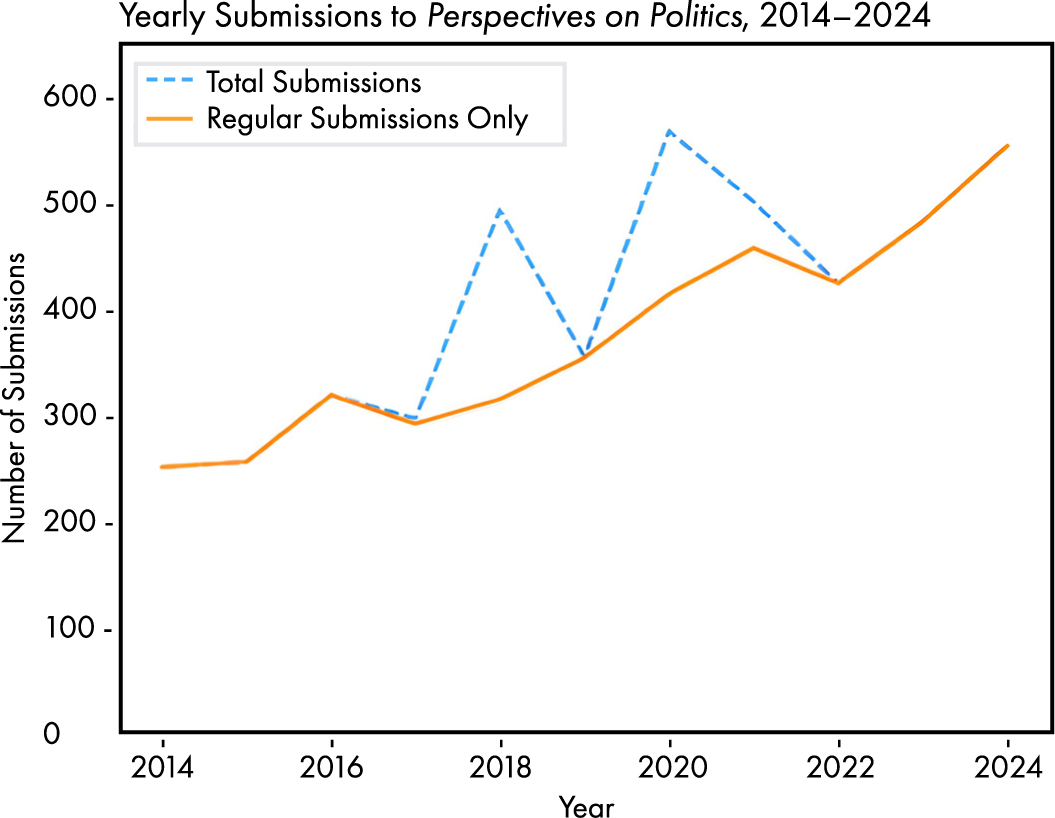
Figure 1. Yearly Submission Volume
Turning to decision times, figure 2 demonstrates the average number of days to first decision for all regular submissions in 2024. Authors typically received initial desk rejection or revise as reflection notifications in 11 days. Among papers sent for external review, authors received notification of the first decision, either revise or reject after external review, in 97 days on average, or about 14 weeks. However, the average time to first decision for submissions rejected after external review (avg. 89 days) and those invited to revise and resubmit (avg. 107 days) is significantly different (p < 0.05). This may be in part due to our policy to reject any manuscripts that receive two or more recommendations for rejection from external reviewers. That is, given that we notify authors of rejections as soon as we receive two or more recommendations to reject, the review time may be substantially decreased compared to those manuscripts for which we must wait for additional reviewers to submit their comments. While our average time to desk rejection remains similar to the metric we reported for 2023, the average time to first decision for papers sent for review increased by 9 days. Accepted articles reached a final decision in 231 days, or 8 months on average, 26 fewer days than the average days to acceptance reported in 2023.
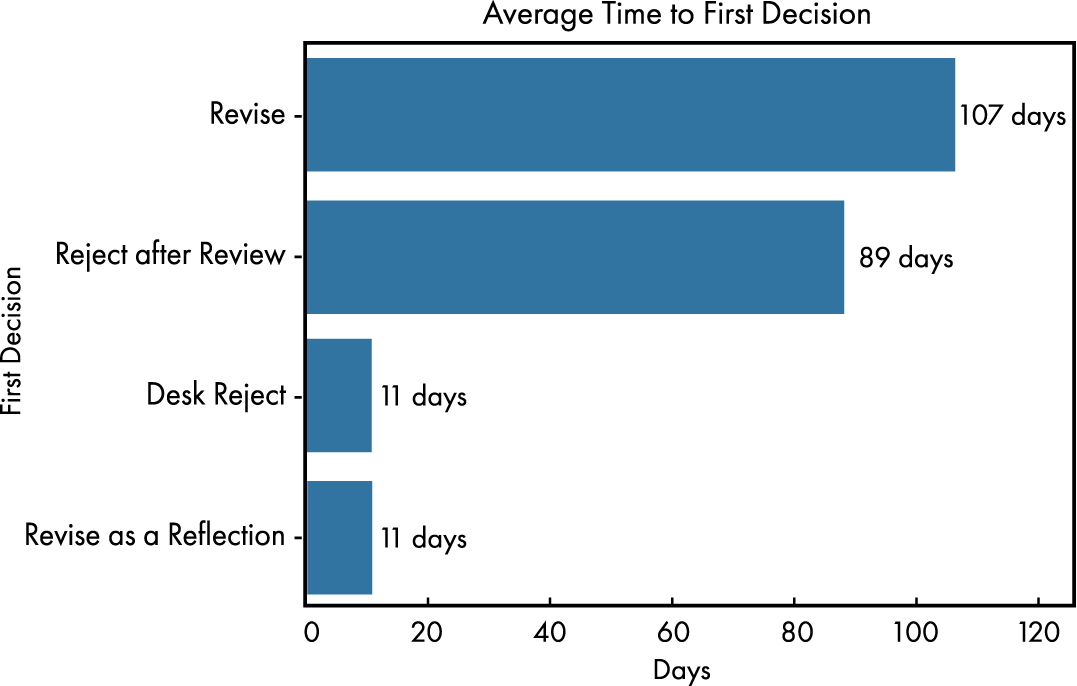
Figure 2. Time to First Decision
With respect to editorial decision-making, table 2 presents the distribution of first decisions for all manuscripts submitted from 2015 to 2024. Of the submissions for which a first-round decision was made in 2024, 55% were returned to authors without external review, indicating that the desk reject rate was slightly lower than the year prior. Of the remaining manuscripts, about 7% were invited to revise as a reflection essay and 38% were sent for external review. Among the manuscripts sent out for review and for which a final decision had been reached by the end of the year, 79% were rejected by reviewers and 21% were accepted for publication after undergoing the revision process.
Table 2. First Round Editorial Decisions (%), 2015–2024
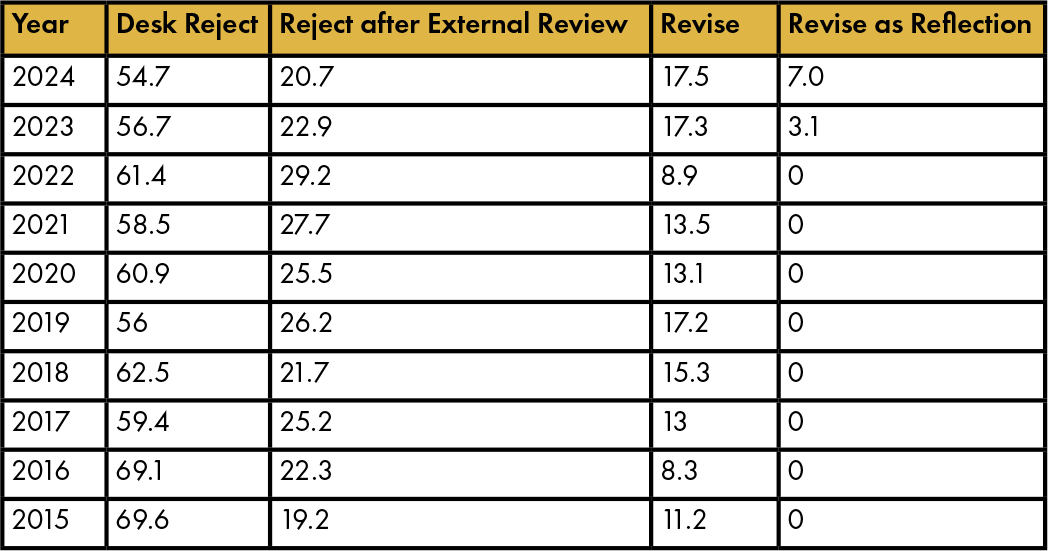
Note: Consistent with our reporting from last year, these percentages are calculated based upon the pool of manuscripts that were submitted in 2024 for which a first decision was made, but not including papers that remained under review or were otherwise awaiting first decision at the time of authoring this report. Therefore, the desk reject percentage is slightly inflated as some papers have been sent for review and are no longer subject to desk rejection. Considering papers that were under review at the time of this report, the share of desk rejected manuscripts was approximately 50%.
BOOK REVIEWS
In 2024, 143 book reviews were accepted for publication in Perspectives. The journal continues to feature several different types of book reviews: conventional book reviews, double book reviews, critical dialogues, review symposia, and book review essays. Table 3 presents the number of book reviews published by the journal in issues released in 2024, given their book review category and subfield. Book reviews were only published in issues 3 and 4 of 2024.
Table 3. Book Reviews Published in Volume 22
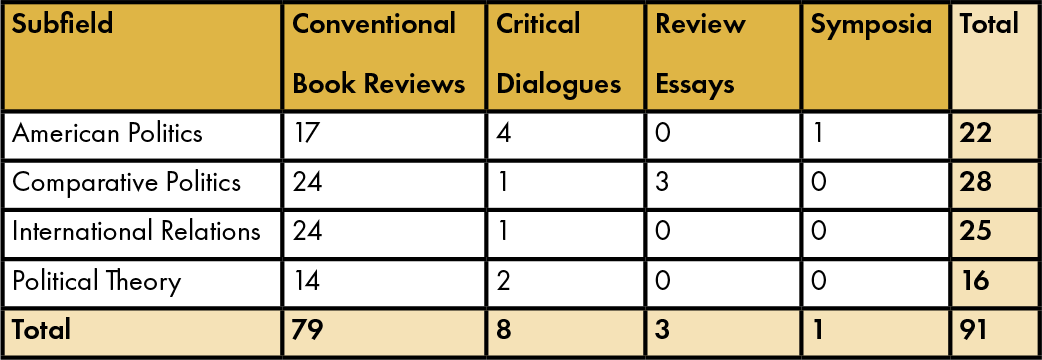
Furthermore, during 2024 the new book review editors made the decision to publish book reviews through the journal’s FirstView online platform before publishing them in specific print issues. This frees the book review team from organizing its publication schedule exclusively around the print issues and will ensure that reviews will be available to readers more quickly, without sacrificing the curatorial value of the print issue. In the medium term, the book review editorial team intends to publish more critical dialogue exchanges, symposia pieces, and book review essays that take a problem-centered approach to evaluating contemporary scholarship. For example, the book review section this year featured key review essays on Chinese politics and the rise of the far-right globally. The book review team also began to include a book review editorial essay in each issue in which they draw together book reviews on similar questions or topics across the subfields. The first of these editorial introductions ran in the December 2024 issue, in which Anne Wolf tackled the problems of misinformation, political rumors, and democratic backsliding.
JOURNAL STATUS IN THE DISCIPLINE
Looking to the journal’s broader standing in the discipline, various scientometric indicators demonstrate that Perspectives remains among the most influential journals in political science. Google’s h5-index indicates that 47 articles published in Perspectives have received at least 47 citations each, resulting in a thirteenth-place ranking on the metric relative to other journals in the discipline. This disciplinary ranking remains the same as that of the previous year. The h5-median indicates that the 47 articles included in the h5-ranking have a median of 71 citations. These metrics remain relatively similar to 2023, when the h5-index for the journal was 45 and the h5-median was 72.Footnote 2
Additionally, Perspectives’ standing based on Clarivate’s two- and five-year Journal Impact Factors from 2023 remain similar to the same metric in 2022. The JIFs correspond to the number of citations that articles received on average in the last two (JIF2) or five (JIF5) years.Footnote 3 Therefore, the 2023 JIF2 indicates that the typical article published in Perspectives received an average of 4 citations in the last two years. Based on the JIF5, the typical Perspectives article was cited 4.4 times on average in the last five years. While neither the JIF2 nor JIF5 are at the metrics’ all-time levels from 2021, the journal ascended to the 92nd percentile for all political science journals given the average JIF. Figure 3 shows the JIF2 and JIF5 for each year from 2010 to 2023.
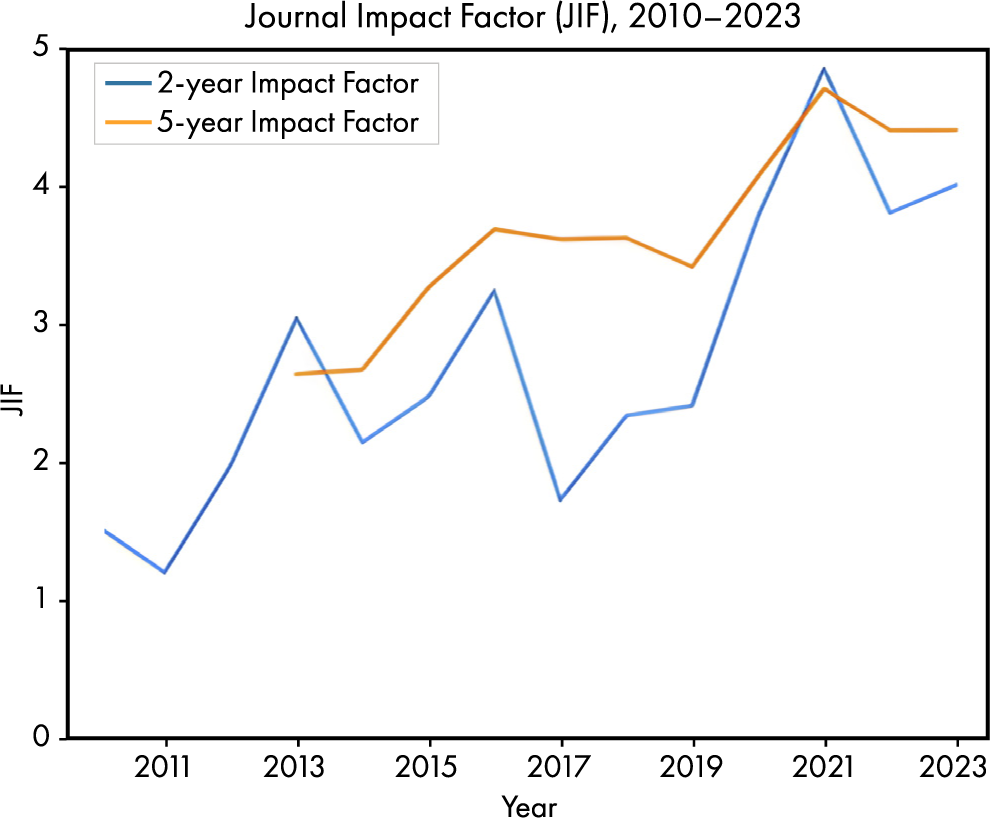
Figure 3. Journal Impact Factor
AUTHOR DEMOGRAPHICS
Building on Bernhard and O’Neill’s editorial vision for Perspectives, we are committed to Perspectives’ standing as a journal that is pluralist not only in its promotion of diverse theoretical and methodological approaches to the study of politics, but also in its aspiration to “publish work that represents the population of the discipline in all its diverse aspects” (Bernhard and O’Neill Reference Bernhard and O’Neill2017, 948). As such, our success in achieving the journal’s mission hinges in part on ensuring that the journal’s editorial outcomes descriptively represent the wider discipline. To evaluate our progress toward this goal, we focus here on gender, location, and race or ethnicity of submitting authors. These data come from author’s self-reported demographic information input into Editorial Manager.Footnote 4
We first turn to gender identity of submitting authors. For all regular submissions to Perspectives in 2024, there were 885 distinct authors. Of these authors, 58% identify as male, 35% identify as female, 1% identify as non-binary, and 6% preferred to not provide their gender identity. The percentage of submitting authors to Perspectives who identify as women (35%) is slightly lower than the reported percent of women compising APSA’s membership (40%) and thus in future years we hope to strategize ways that promote increased submission by women (co)authors (American Political Science Association, “APSA Membership Dashboard”).Footnote 5 However, we have implemented strategies in later stages of the publishing pipeline that we hope, in part, offset the consequences of this disparity. For example, when planning issues, we consider the gender composition of authorship teams and whether articles have women listed as co-authors. We curate each issue to ensure that there is a balance on these two metrics for all the published articles to the extent possible. Moreover, we have featured special sections which focus on gender in politics, such as in 22(1)’s special section on Women, Representation, & Politics.Footnote 6
Another issue of concern is the journal’s international reach, and data show that this reach increased and remained relatively stable in recent years. Furthermore, like previous years, the percentage of authors submitting from outside the US in the last year was greater than the percentage submitting from within the US, as shown in table 4. Authors submitting to the journal in 2024 came from 57 distinct countries, each of which is highlighted in blue in the map displayed on figure 4.
Table 4. Balance between US Based and Non-US Based Authors (%)
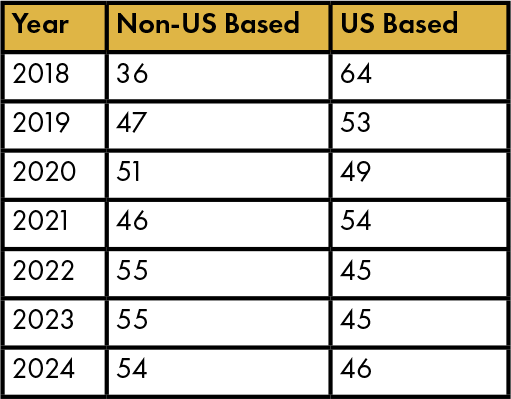
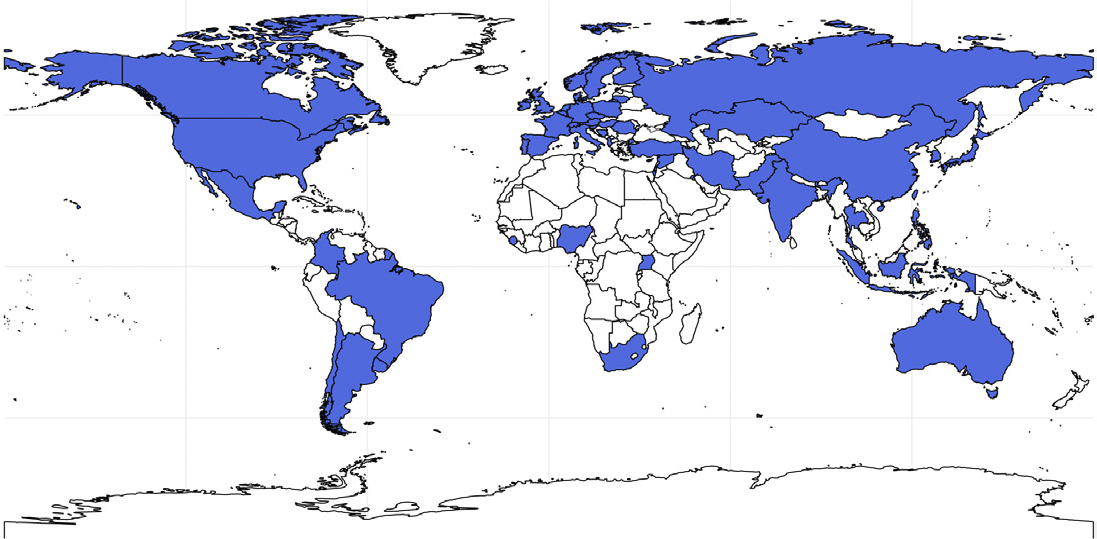
Figure 4. Author Locations Worldwide, 2024
Lastly, we examine the distribution of author demographics given submitting authors’ reported race or ethnicity. We present these data as we believe that they are important to faithfully assess the journal’s progress toward equity and inclusion across different segments of the academic community in publishing outcomes. However, our reporting on these metrics is limited to the types of racial and ethnic categories collected by APSA upon manuscript submission. These categories include European/Anglo White; Asian or Asian American; Latino/a; Middle Eastern or Arab American; Black, Afro-Caribbean, or African American; Non-European/Non-Anglo White; Native American, First Nations, or Indigenous Peoples; Other; or prefer not to answer. In the case that authors reported membership in two or more racial or ethnic categories, we have classified their response as Multiple Race or Ethnicities. Figure 5 presents the distribution of authors given their self-reported racial or ethnic identity. Most authors report that they are European/Anglo White (59%). While the relative distribution of all other non-European/Anglo White categories is less than 15% each, the racial or ethnic composition of submitting authors largely reflects that of the larger discipline as per APSA membership demographics.
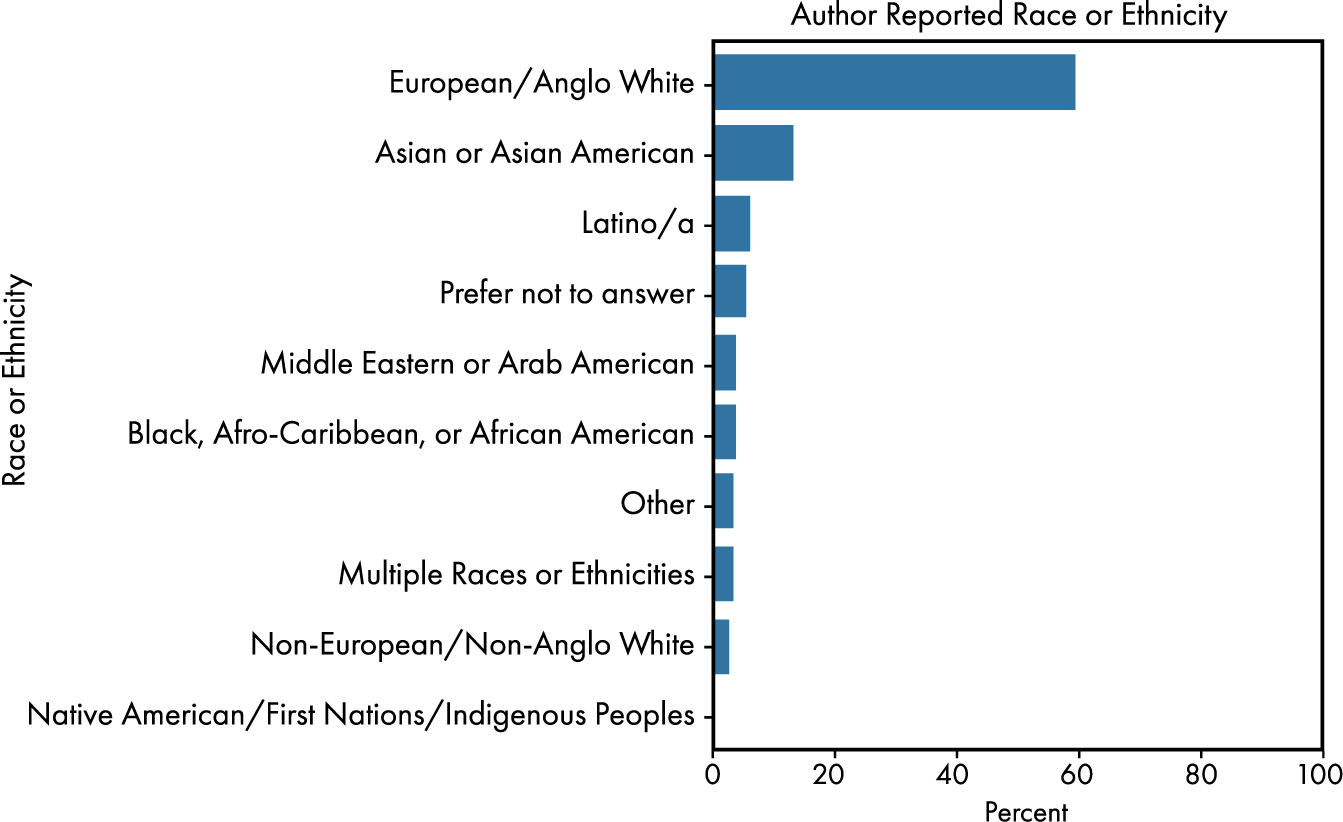
Figure 5. Self-Reported Race or Ethnicity of Submitting Authors
CONCLUDING REMARKS
Throughout the last year, we endeavored to further develop our editorial processes, outline systematic policies for difficult decision-making, and identify sources of ongoing editorial innovation. As a result of these efforts, we have deepened our expertise in efficiently managing a major academic journal and hope that this has resulted in productive experiences for submitting authors and external reviewers. The metrics outlined in this report reveal that, at the least, the editorial outcomes from 2024 remain on par with previous years.
Turning to 2025, we will continue projects that we began in 2024 related to protocols for reporting on human participants research and survey research transparency, post-publication critiques, and artificial intelligence (AI) use policies. We will also look forward to receiving and engaging with submissions related to the call for papers on “Political Science and the University,” a topic we believe to be particularly timely as academic research and freedom comes under increasing threat. ■
